Orkney world heritage sites threatened by climate change
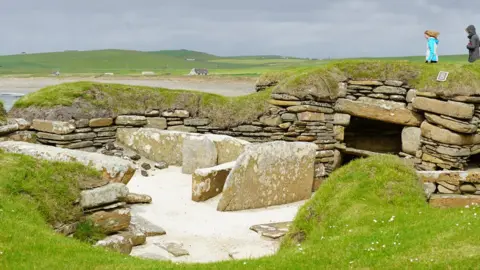 BBC
BBCThe world heritage status of Orkney's archaeological treasures is threatened by climate change, a report has warned.
Rising seas and higher rainfall mean the Heart of Neolithic Orkney site is "extremely vulnerable", experts said.
Their assessment is being presented at a Unesco meeting in Baku, Azerbaijan.
The method used to assess the impact of a warmer, wetter climate on Orkney could eventually be rolled out to all 1,092 Unesco World Heritage Sites.
"The threat here is very real in terms of survival of the site," Ewan Hyslop, head of technical research and science at Historic Environment Scotland, told BBC Scotland's The Nine.
"The global projections for sea level rise are quite astonishing," he said, citing a prediction that sea level around the world could be a metre higher by 2100.
The greatest concern on Orkney surrounds the village of Skara Brae which is believed to have been occupied about 5,000 years ago - between about 3100BC and 2500BC.
The archaeological site was first revealed in 1850 when a storm stripped away the sand dune which covered it.
The new report concludes that the potential for damage from sea level rise is "particularly acute" at the Neolithic settlement.
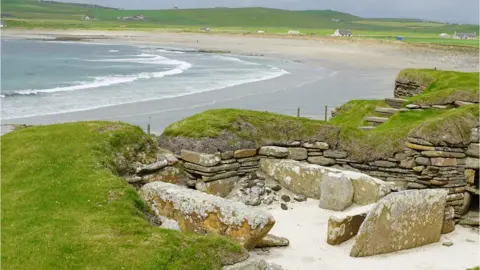
It was compiled by the government agency Historic Environment Scotland along with academics and scientists, Orkney Islands Council and members of the public.
Neolithic Orkney is the first cultural World Heritage site to pilot this type of risk assessment, known as the Climate Vulnerability Index.
The tool has only been used once before, on a natural World Heritage site, at Shark Bay in Western Australia.
It examines vulnerability to climate change in two aspects: damage to the intrinsic cultural value of the site and impact on the local community.
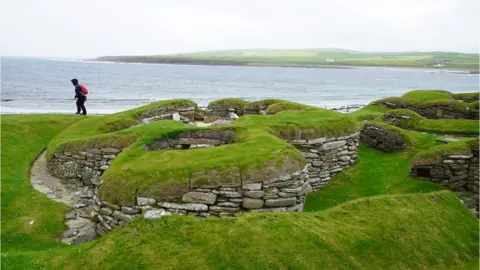
For the Orkney site the cultural impact was deemed to be in the highest category (high) while the community vulnerability was judged to be moderate, acknowledging the resilience and adaptability of Orcadians.
Local tourist guide Patricia Long told BBC Scotland's The Nine that view was one that chimed with her experience as an islander.
"The thing about the social history here is how we take what is the next thing and we make the most of that," she said.
"And when that moves on, whether it's herring shoals moving on or the end of the war, we look at the next thing. Of course now it's renewable energy."
"From Skara Brae onwards we deal with what there is," she said.

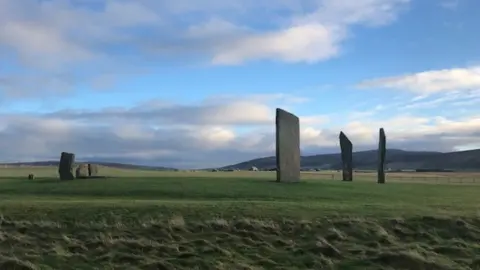 Patricia Sinclair
Patricia Sinclair Skara Brae is just part of the World Heritage site on Orkney which also consists of the chambered tomb of Maeshowe; the Stones of Stenness; and the Ring of Brodgar, a stone circle.
There are currently five other World Heritage sites in Scotland: the Forth Bridge; the Antonine Wall; New Lanark; the Old and New Towns of Edinburgh; and St Kilda.
Two Scottish sites are on the tentative list for status: the Flow Country of Caithness and Sutherland; and the Crucible of Iron Age Shetland.
Their report, quoting Met Office data, finds that between 1961 and 2004 there was an increase in the average temperature in the north of Scotland region of 1.03C.
At the same time average precipitation rose by 21%, with days of heavy rain up 8.2%, also according to the Met Office.
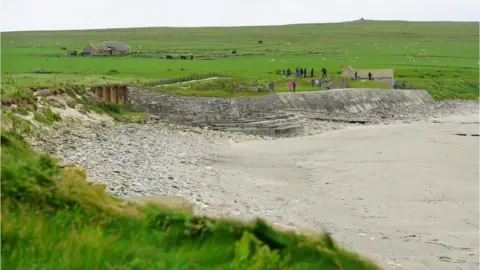
A tidal gauge at Wick, about 40 miles from Orkney on the north east coast of the Scottish mainland, recorded increases in sea level of 3.06mm per year from 1992 to 2013.
And, while data for storm intensity and frequency are not conclusive, it warns that "there exists the potential for a single extreme event destroying part of Skara Brae".
Scott Heron, of the college of science and engineering at James Cook University in Queensland, Australia, who helped prepare the report, said: "The workshop ranked the vulnerability for the Orkney World Heritage site at the highest level, with greatest risk from precipitation change, sea level change and storm intensity and frequency."
"Climate change is the fastest growing threat to world heritage sites," said Adam Markham, deputy director of the climate and energy program at the Union of Concerned Scientists, which was also involved in the report's production.
"There is no standardised way to assess vulnerability," he said, adding that the Climate Vulnerability Index was designed to fill that gap.
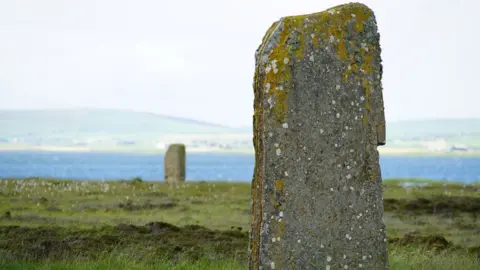
The meeting in Baku will now consider whether the index should be rolled out to all other world heritage sites.
The need is urgent, warns Mr Markham, who outlines the dire impacts of climate change on many of the world's most important cultural and natural treasures.
"Sites worldwide are being damaged and degraded by melting glaciers, rising seas, intensifying weather events, worsening droughts and longer wildfire seasons," he said.
